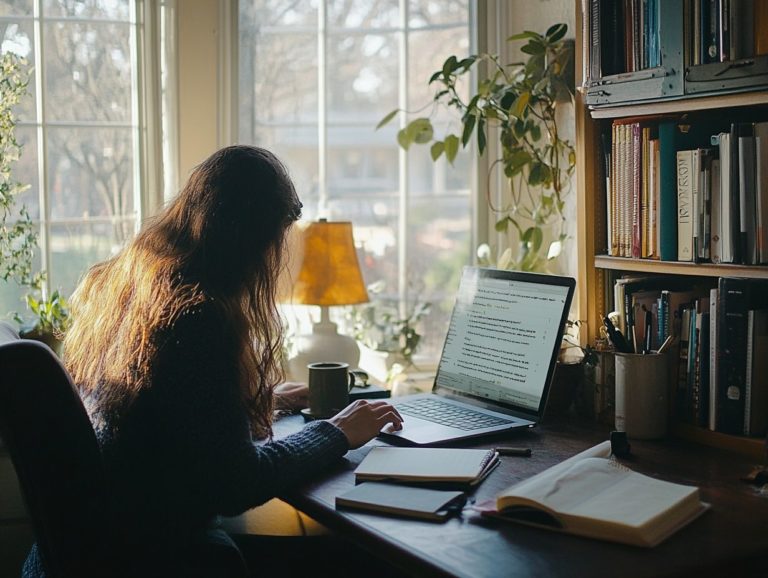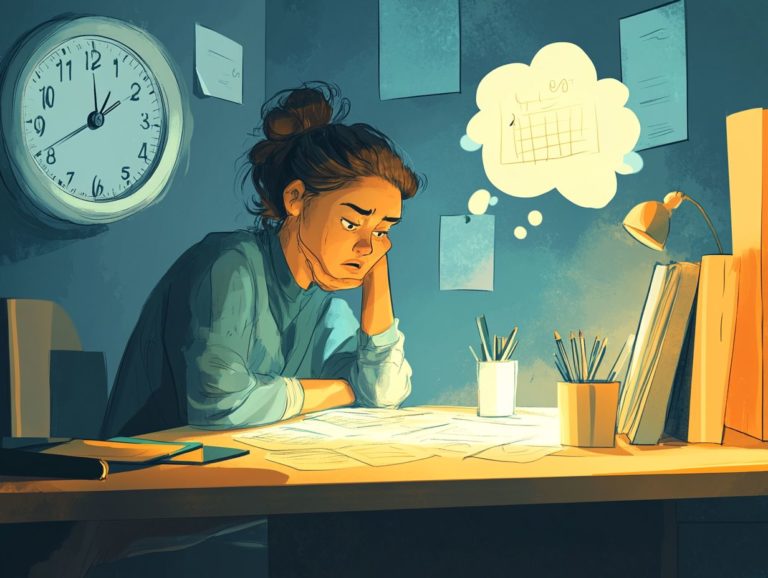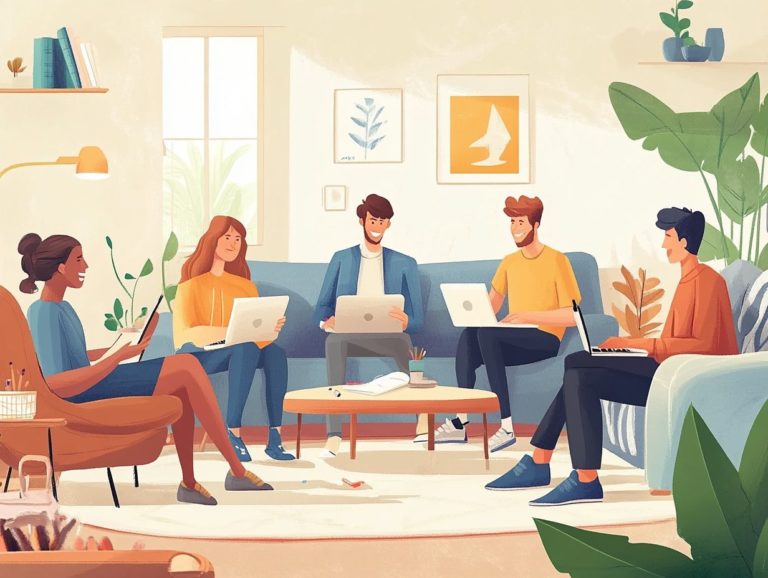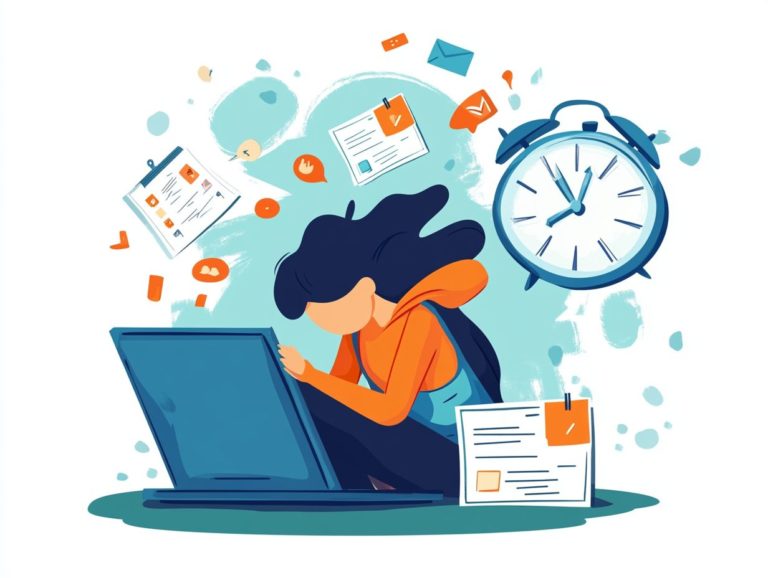How to Overcome Procrastination with Minimalism
Procrastination often presents itself as an insurmountable hurdle, fueled by distractions and the overwhelming array of choices that life presents. But what if minimalism held the key to breaking that cycle? Let s explore the intricate relationship between procrastination and minimalism, illuminating their underlying causes and effects.
By embracing a minimalist lifestyle, you can significantly reduce distractions, prioritize tasks more effectively, and ultimately enhance your productivity. With practical tips and insights at your disposal, learn how to simplify your life and conquer procrastination once and for all.
Contents
- Key Takeaways:
- Understanding Procrastination
- What is Minimalism?
- How Minimalism Can Help with Procrastination
- Practical Ways to Incorporate Minimalism into Daily Life
- Overcoming Procrastination with Minimalism
- Benefits of Combining Procrastination and Minimalism
- Frequently Asked Questions
- 1. What is the relationship between minimalism and procrastination?
- 2. How can minimalism help me overcome procrastination?
- 3. Can minimalism be applied to digital clutter?
- 4. How can I use minimalism to prioritize my tasks and avoid procrastination?
- 5. Can minimalism help me overcome procrastination in my personal life as well as work?
- 6. How can I start incorporating minimalism into my daily routine to overcome procrastination?
Key Takeaways:
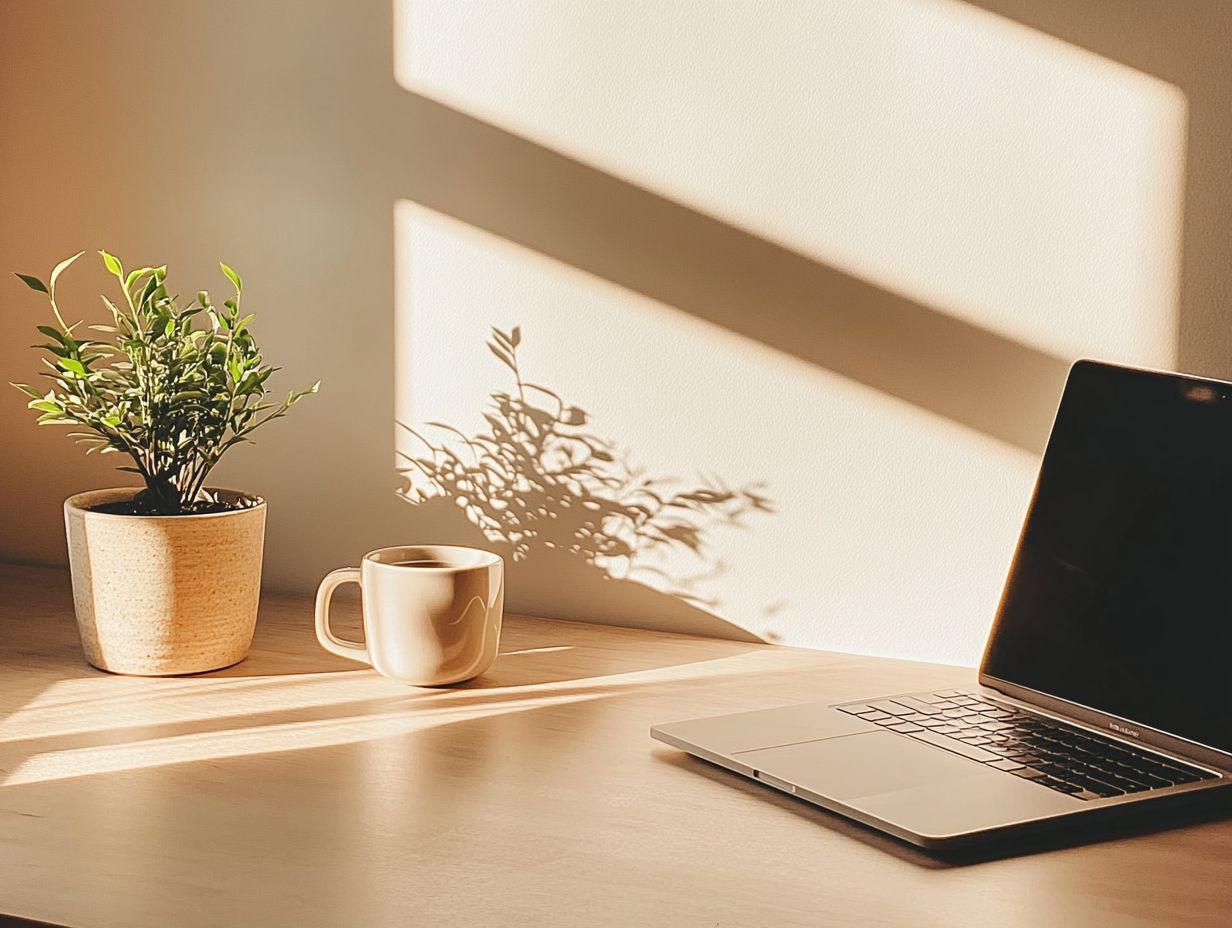
- Understanding procrastination can help you identify its causes and effects, making it easier to combat with minimalism.
- Minimalism focuses on simplicity and prioritization, providing an effective way to reduce distractions and overcome procrastination.
- Incorporating minimalism into daily life through decluttering, simplifying, and setting realistic goals can lead to increased productivity and mental clarity.
Understanding Procrastination
Procrastination is a multifaceted behavioral challenge that impacts individuals in many areas of life, often resulting in heightened stress, anxiety, and reduced productivity.
Research indicates that its origins often lie in poor time management, digital distractions, and a lack of self-compassion, which can perpetuate a relentless cycle of avoidance. Notable philosophers like Seneca and contemporary thinkers such as Niall have explored its implications, underscoring the importance of grasping the nature of procrastination.
By doing so, you can cultivate effective productivity strategies and regain command over your daily routine and aspirations.
Causes and Effects
The causes of procrastination can differ significantly among individuals, yet common factors often emerge, such as poor time management, overwhelming digital distractions, and a lack of self-compassion.
You might feel paralyzed by the sheer volume of tasks, leading to rising anxiety and feelings of inadequacy. Emotional elements like fear of failure or perfectionism can intensify the urge to delay, trapping you in a cycle that undermines your productivity and mental well-being.
Environmental conditions like a cluttered workspace can be significant barriers to your focus. This complex interplay of psychological and emotional challenges hinders your ability to complete tasks efficiently and cultivates frustration, ultimately impacting your self-esteem and overall mental health.
What is Minimalism?
Minimalism is not just a trend; it s a refined lifestyle choice that champions simplicity and intentionality. It invites you to declutter your physical space and prioritize what genuinely matters in your life.
This philosophy transcends mere possessions; it encourages you to cultivate a mindful daily routine and establish clear, purposeful goals. By embracing minimalism, you can significantly reduce distractions, fostering an environment that enhances productivity and personal growth.
Ultimately, this approach leads you toward a more fulfilling and enriched life.
Definition and Principles
At its core, minimalism invites you to embrace simplicity, intentionality, and the conscious choice to prioritize meaningful experiences over material possessions.
By adopting these principles, you often uncover a profound sense of mental clarity and focus. When you reduce clutter both physical and digital you cultivate an environment that fosters creativity and mindfulness.
This practice helps you forge a deeper connection with the present moment, liberating you from the relentless distractions of modern life, like incessant notifications and shallow social media interactions.
As a result, those who embrace this lifestyle frequently report heightened productivity and an enriched quality of life, leading to a harmonious balance between what truly matters and what is merely excess.
Start simplifying your life now and see how it transforms your productivity!
How Minimalism Can Help with Procrastination
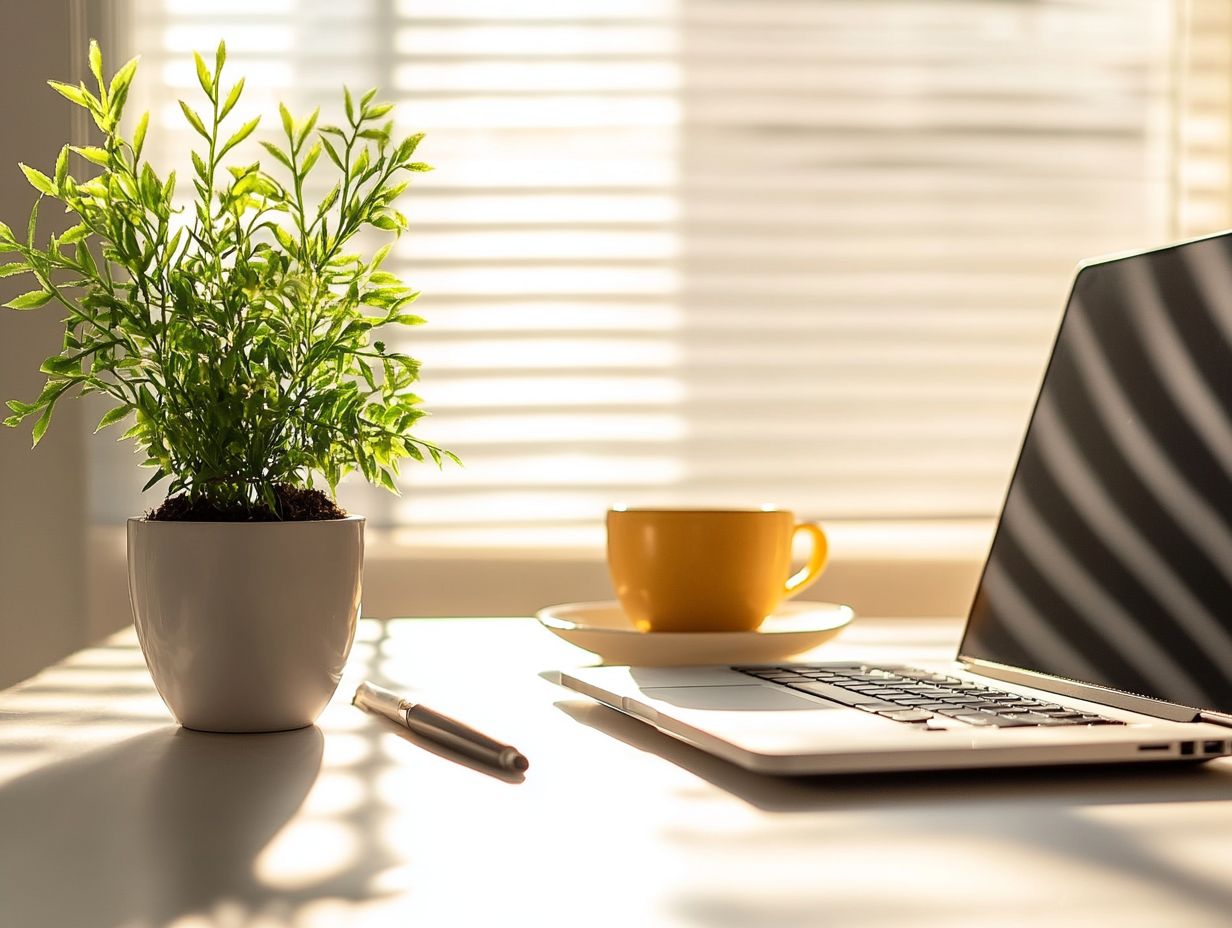
Minimalism acts as a potent remedy for procrastination. It helps you cut through distractions and prioritize your tasks with intention. In a world overflowing with digital interruptions, embracing minimalism can transform your daily routines and create an environment that nurtures productivity. For those looking to enhance their approach, exploring how to overcome procrastination with self-care can provide additional valuable insights.
By shedding the unnecessary, you free yourself to focus on what genuinely matters. This fosters improved habits and a clearer mindset.
Reducing Distractions and Prioritizing
Minimize distractions. This helps you prioritize your tasks more precisely. Embracing minimalism allows you to create a focused environment. For those struggling with procrastination, learning how to use negative visualization can also be beneficial. Keep clutter at bay and only have essential items in view.
This mindset clears your physical space and liberates your mental space. It fosters clarity that enhances your time management skills.
Set clear boundaries now for your digital devices consider using apps that block distracting websites during work hours. Forming a daily routine with designated time slots for tasks can significantly boost your productivity.
By cultivating these habits, you can transform your daily life into a more organized and serene experience.
Practical Ways to Incorporate Minimalism into Daily Life
Incorporating minimalism into your daily life brings remarkable benefits, such as heightened productivity and clarity of thought. It helps you establish a well-defined plan for your day.
By prioritizing the decluttering of both your physical surroundings and mental obligations, you can create a streamlined routine. This nurtures engagement in meaningful activities and alleviates feelings of overwhelm.
This intentional approach enables you to navigate life with purpose and efficiency, transforming your everyday experience.
Decluttering and Simplifying
Decluttering your physical space is a cornerstone of minimalism. It can significantly enhance your productivity and mental clarity.
By removing unnecessary items, you cultivate an atmosphere that promotes focus and creativity. One effective strategy is the two-minute rule: tackle any task that can be completed in two minutes right away. This prevents small clutter from piling up.
Creating a simplified environment allows you to intentionally curate your surroundings. Keep only items that serve a purpose or bring you joy. These practices boost your efficiency and nurture a mindset aligned with minimalism, leading to a smoother workflow and improved well-being.
Creating a Minimalist Workspace
Designing a minimalist workspace elevates your productivity. It creates an environment that nurtures focus and minimizes distractions.
A thoughtfully planned layout is vital; it promotes efficient movement and keeps clutter at bay. An organized setup, containing only the essential tools, lays the groundwork for an optimal workflow.
Consider incorporating features like adjustable desks and ergonomic chairs. These enhance your physical comfort and sharpen your mental clarity.
Employ smart storage solutions, such as hidden compartments or wall-mounted shelves. This helps you manage items effectively while keeping your surfaces clear and inviting.
By adopting productivity techniques, such as setting specific times for tasks, you can harness your streamlined workspace. This reduces interruptions and fosters a more focused work routine.
Begin your minimalist journey today and experience enhanced focus and productivity!
Overcoming Procrastination with Minimalism
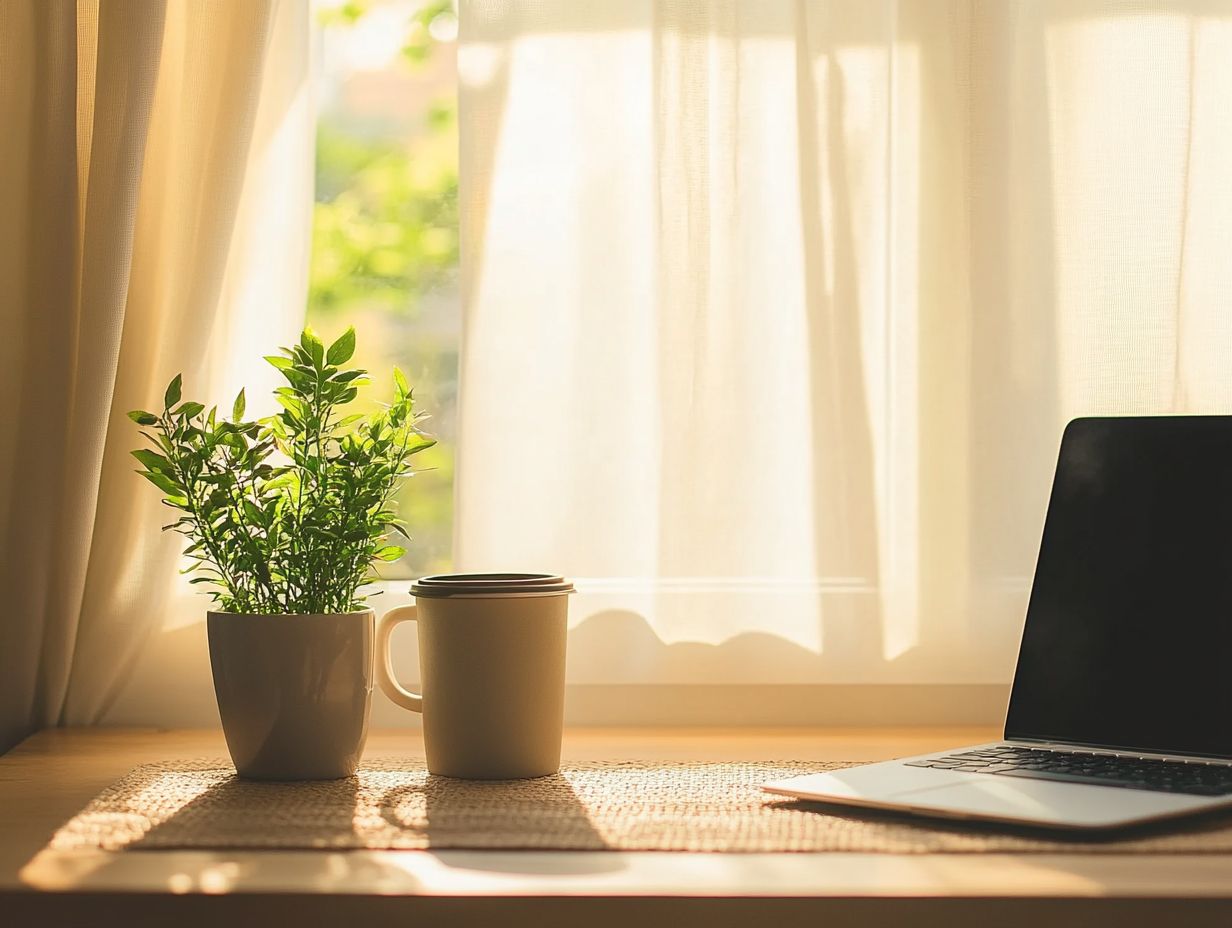
Overcoming procrastination is within your reach through the strategic adoption of minimalist habits that focus on setting realistic goals and honoring deadlines. By embracing this minimalist approach, you can simplify your tasks and carve out a clearer path toward achieving your objectives, as outlined in how to overcome procrastination with simple steps.
This proactive mindset reduces the chances of succumbing to procrastination and cultivates a profound sense of achievement and fulfillment in your journey.
Implementing Minimalist Habits
Implementing minimalist habits can significantly enhance your time management skills. This is achieved by reducing the clutter in your daily routine.
By simplifying tasks and embracing a more intentional approach to your activities, you create an environment that fosters focus and efficiency. For instance, adopting the two-minute rule allows you to tackle small tasks immediately rather than letting them accumulate into a daunting to-do list.
Incorporating mindfulness practices, such as meditation or deep-breathing exercises, heightens your awareness, enabling better decision-making and prioritization. These strategies streamline your workflow and create clarity, allowing creativity to flourish.
Minimalist habits pave the way for achieving more with less effort, transforming how you navigate your daily life.
Setting Realistic Goals and Deadlines
Setting realistic goals and deadlines is essential to preventing procrastination and fostering sustainable productivity.
When you adopt a minimalist approach to goal-setting, the process becomes less overwhelming and more manageable. This involves breaking down larger objectives into smaller, actionable steps and prioritizing tasks based on their urgency and significance.
By focusing on a few key goals rather than drowning in a lengthy list, you maintain clarity and direction. Regularly reflecting on your progress enables you to adjust your strategies, ensuring your journey stays aligned with your desired outcomes.
Embracing simplicity sharpens your focus and nurtures a sense of accomplishment, paving the way for continued success.
Benefits of Combining Procrastination and Minimalism
The blend of minimalism and effective procrastination strategies offers a wealth of benefits, such as increased productivity and enhanced mental clarity. By embracing minimalism, you can create an environment that reduces distractions and fosters a focused mindset, making it easier to learn how to set realistic goals to overcome procrastination.
This transformation enables you to accomplish tasks more efficiently and achieve your goals with greater ease.
Improved Productivity and Mental Clarity
One of the most significant advantages of embracing minimalism to combat procrastination is the remarkable boost in both your productivity and mental clarity, which can be enhanced by learning how to turn procrastination into motivation.
By clearing away unnecessary distractions and clutter from your surroundings, you create a focused mindset that enhances your workflow. This intentional reduction transforms your workspace into a serene environment, allowing you to concentrate deeply on the tasks that truly matter.
Techniques like the Pomodoro Technique (a time management method where you work in focused bursts) become even more effective in a minimalist setting, as the absence of visual noise fosters sustained attention.
Mental simplicity brings a sense of calm, helping to reduce exhaustion from making too many choices. Ultimately, this paves the way for improved task execution and heightened creative problem-solving.
Frequently Asked Questions
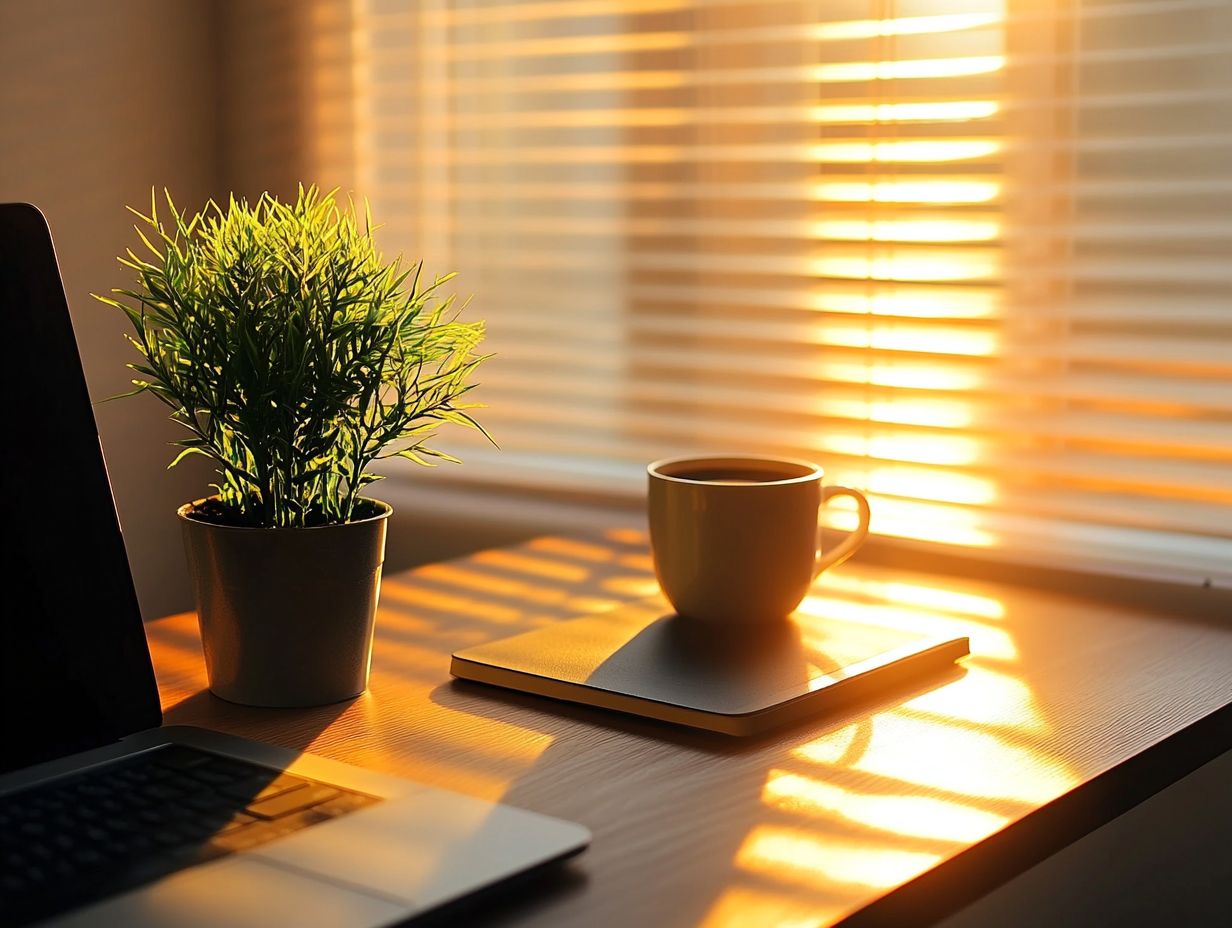
1. What is the relationship between minimalism and procrastination?
Minimalism is a lifestyle that intentionally simplifies one’s possessions and prioritizes what is truly important. Procrastination, on the other hand, is the act of delaying or avoiding tasks. By adopting minimalism, you can eliminate distractions and focus on completing tasks. Additionally, learning how to use visualization to overcome procrastination can further enhance your productivity.
Start your journey towards minimalism today and see how it can change your productivity!
2. How can minimalism help me overcome procrastination?
Minimalism helps you overcome procrastination by clearing out unnecessary clutter. This creates a focused environment, allowing you to tackle tasks without delay. For more insights, check out how to overcome procrastination with time management.
3. Can minimalism be applied to digital clutter?
You can also apply minimalism to your digital clutter. By decluttering your phone and computer, you eliminate distractions and boost productivity.
4. How can I use minimalism to prioritize my tasks and avoid procrastination?
Thinking more simply allows you to prioritize tasks based on what truly matters. This focus helps you complete the most important tasks first, minimizing procrastination.
5. Can minimalism help me overcome procrastination in my personal life as well as work?
Absolutely! Minimalism can simplify all areas of life, including personal tasks. Decluttering your personal space creates calm, enhancing your focus and helping you beat procrastination. For more strategies, check out how to use deadlines to overcome procrastination.
6. How can I start incorporating minimalism into my daily routine to overcome procrastination?
Start your journey by decluttering your physical and digital spaces. Prioritize your tasks and set aside time each day to reflect on what matters most to you.
Begin adopting these habits today to beat procrastination and achieve your goals!

